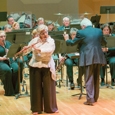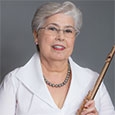
Professional musicians often perform the same work multiple times. While students often wish for a second (or third or fourth) chance to perform a piece, hoping to correct mistakes, professionals who have mastered the music instead face a different challenge as they strive to keep the music fresh and exciting after many repetitions. There are many scenarios in which professionals are required to repeat performances:
Soloists may play the same recital multiple times.
Orchestral players usually play the same program two to four times within a week.
Opera and ballet musicians give multiple performances of the same works over a given period of time.
Orchestral musicians for a musical show may play the same music for years.
In all of these scenarios the performers are responsible for doing the best they can; however, depending on the situation, a good performance will also require varying degrees of collaboration with colleagues.
Musical Shows
This can be the most difficult to keep fresh because looking at the same music day after day can easily become mind-numbing. Musical theater can be like Mission Impossible – it can present many exciting challenges – should you choose to accept them. There is the challenge of working with colleagues in the orchestra. A show that goes on for a long time will have frequent substitute players, so the first challenge is to work with new colleagues so that everyone is comfortable. Accept what new players bring to the music while still keeping things somewhat as they always are. New people will not always be in the pit; there will be new singers on the stage as well. Hopefully, they too will want to bring something special to each performance, and that may mean changes in timing or dynamics. Within the context of the group performance, continue to bring something of your own talents and vision to the music as well.
Ballet
A ballet is probably the most challenging forum in which to keep things fresh. Because it is important to keep the music (especially tempos) the same for the dancers, there is much less room for individuality. However, I will never forget hearing Andy Lolya of the New York City Ballet performing Claude Debussy’s Afternoon of a Faun. It was very slow and very beautiful. That gorgeous piece provides a wonderful chance to vary vibrato and tone colors and to make the piece your own with each performance.
Opera
Opera, my area of greatest experience, can provide an excellent forum for making a piece fresh and different each time. The conductor, of course, will be a great part of that. I loved conductors who never did a piece the same way twice. Valery Gergiev was such a conductor. That “by the seat of your pants” kind of music-making provides an excitement that provokes individuality without even thinking about it. Even with conductors who want to do the same thing every time, however, there is room for freshness and individuality in performance. Singers may change their interpretations or new singers may join the production, so that too provides variability. Hopefully, colleagues will also try to bring something special to each performance. As you blend with them, listen to what they are doing, and try to answer in an interesting way – perhaps echoing or answering what they are saying. With the cooperation of the conductor, you might decide to take a little more time on a particular phrase. If you do something special, very likely not only will the conductor appreciate it, but colleagues may pick up on it and perhaps go on to add their own touch to it.
Performing with singers is a particular challenge. They are not sitting in front of a score as the instrumentalists do and tend to be freer with the music as a result. Be aware of what they are doing, be flexible and go with them – imitate them, wait for them, and do whatever is necessary.
The Mad Scene in Lucia de Lammemoor by Gaetano Donizetti is a perfect example of working intimately with a singer. I was fortunate during my time at the Metropolitan Opera to perform that scene standing in the front of the pit so that I could view the singer. The singers varied from those who attempted to always do the same thing to those who were wildly different each time. My job was to follow, to imitate, and to make music with them; but interestingly and most importantly it was also to make the singer comfortable. Once they were sure that they could count on me to be there with them, they felt freer to do what they would like to do. My favorite soprano with whom to do the Mad Scene was Ruth Ann Swenson. When we arrived at the cadenza, I knew that she was completely comfortable. There were passages where I echoed her and passages where I played with her. We both took time between phrases and had so much faith and comfort with each other that it was always together. On more than one occasion, as we practiced the opera in the rehearsal room, we played the cadenza perfectly together with my back to her and no conductor. We performed it many times over the years, and I am quite sure that no two performances were the same.
Orchestral Concerts
In orchestral concerts the personnel usually remains the same, and the concerts are performed within a short period of time – most often the same week. That being said, again depending on the rigor of the conductor, this might offer the most room for individuality with each performance. Probably there will be less flexibility with the tempos and yet the musicians should try to say something special each time. I was privileged to hear a wonderful example of that this New Year’s Eve. The New York Philharmonic performed Camille Saint-Saëns Carnival of the Animals on a live telecast. There can be nothing simpler than the clarinet’s statement of the cuckoo’s theme – two notes over and over. New York Philharmonic’s principal clarinet, Anthony Magill, gave an absolutely entrancing performance in which each statement of those two notes said something different than all the others. It was fascinating.
Recitals
Professional soloists often perform the same works again and again. However, even musicians who are not professional soloists will perform many of the same pieces more than once. The last thing you want to do is to play a piece in the same way as when you first learned it. Prepare them anew each time and bring all the knowledge and experience you have gained in the meantime. Experience should give performers confidence. With that most often comes the joy of saying what we would like to with every performance.






